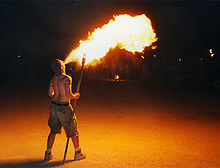Pyrofluid
A flammable, liquid substance is called a pyrofluid .
Fire-breathers often use special liquids (similar to petroleum ) available in stores under this or a similar name for their work outdoors . This liquid substance has the advantage that it has a higher flash point than alcohols and other hydrocarbons such as e.g. B. has gasoline or alcohol. As an alternative to oils, bear moss spores , so-called Lycopodium bisdepuratum , are used to spit fire. These have the advantage of producing a larger ball of flame and developing a flame that is not quite as hot. For reasons of fire protection law, this alternative variant is therefore preferably used indoors.
Fire-breathing substances should only be used under the guidance of experienced fire-breathers, but now many specialist shops generally advise against fire-breathing and some mail-order companies have removed Pyrofluid from their range.
The flash point is very important here: If this is too high, the flame will move away. If it is too low, the flame moves very close to the face.
Pyrofluid should not ignite with a match or a lighter at room temperature. This is the only way to ensure that no pyrofluid can easily ignite in the event of an accident on the face or body of the person concerned.
Health hazards
If pyrofluid gets into the airways, there is a risk of very serious damage to the health of the lungs, which can even lead to death. Bear moss spores are also dangerous - especially in the presence of asthmatics or when used by asthmatics.
The use of gasoline, alcohol, acetone , nitro-thinner and other substances as pyrofluid for breathing fire repeatedly leads to severe burns, deaths and / or cases of poisoning.
